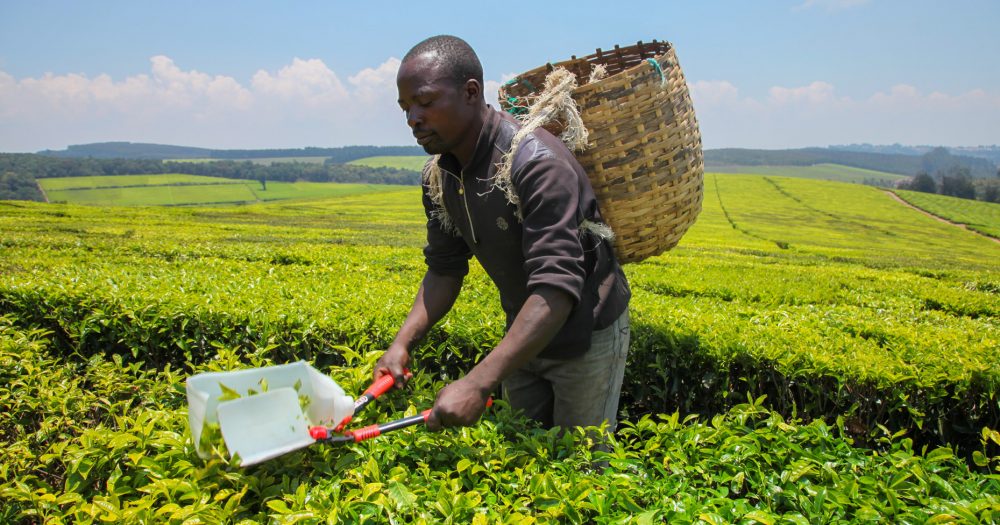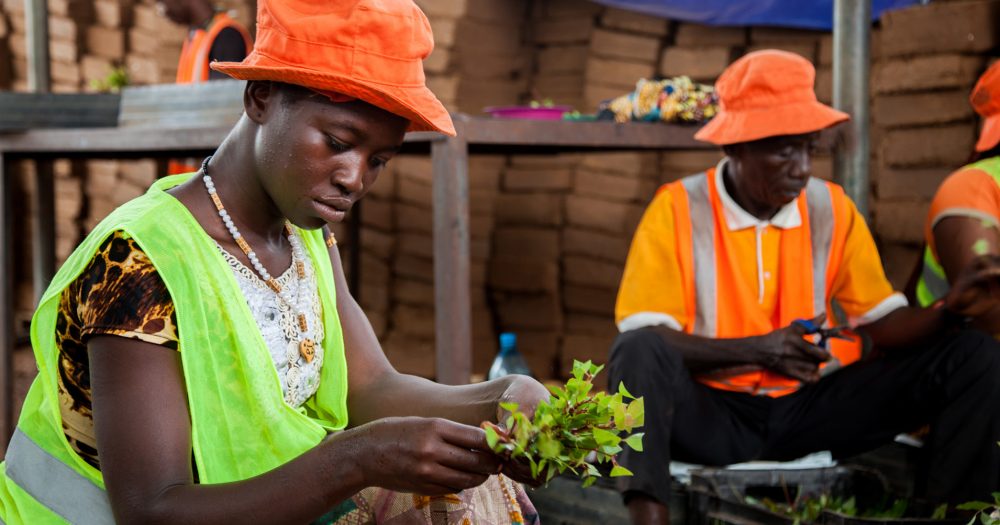Our investment
Description of the investment.
Description of the investment.
This is an equity investment in Namdev Finvest Private Limited where we co-invested alongside Incofin India Progress Fund I.
Namdev is a lender focused on micro, small and medium enterprises (MSMEs), based in Rajasthan, India. It provides secured loans to customers in rural areas who are new to credit (approximately 30 per cent) or have limited credit history (approximately 70 per cent). The company offers loans for predominantly income-generating assets and is active through two main products: MSME loans (87 per cent) and two-wheeler loans (11 per cent). Namdev recently launched a first electric vehicle/solar loan product, financed by the Symbiotics Green Basket Bond (backed by BII) which it plans to scale over the next few years.
The company is highly focused on rural lending and scaling up its green financing portfolio. Its data suggests that 66 per cent of its customers have monthly household incomes below INR 28,000 (BII’s low-income proxy for India). Furthermore, because many of Namdev’s customers are new to credit, this supports financial and economic inclusion, as lower-income individuals are less likely to secure finance from traditional lenders. Namdev also has women as primary applicants on 30 per cent of its loans and women are mandatory co-applicants on all loans.
As part of the overall fundraise, our capital will help support Namdev’s growth including an increase in Namdev’s loan book, geographic expansion, and employment base. We are having financial additionality by helping Namdev successfully complete the fundraising round.
Impact information
Applies to investments made from 2019 onwards. The tabs in this section define what we expect to achieve through the investment, assessing the potential impact of the investment against six dimensions of impact. You can find more details on our methodology of assessing impact here.
Applies to investments made from 2019 onwards. The tabs in this section define what we expect to achieve through the investment, assessing the potential impact of the investment against six dimensions of impact. You can find more details on our methodology of assessing impact here.
What?
| Impact |
|---|
Improved economic opportunities by increasing access to finance for MSMEs in India, some of which have no prior access to credit, allowing them to participate more efficiently in the economy and scale their businesses (SDG 8.3, 8.10). |
|
|
How?
| How? |
|---|
|
The investment will increase access to finance among underserved customers in India. By being able to access loans, often for the first time, MSMEs and self-employed individuals will be able to better manage their liquidity and meet their growth needs. This will ultimately contribute to more stable and increased income for them and their families. In addition, the expansion of Namdev's branch network will create additional company jobs. |
Who?
| Stakeholder | Geography | Characteristics |
|---|---|---|
| Customers |
India (100 per cent): Branches in Tier II and Tier III cities across four states and union territories |
The typical MSME customer profile includes kirana stores (mom-and-pop stores), fruit and vegetable vendors, small farmers and dairy suppliers. Approximately 33 per cent of these borrowers are considered low-income as per BII’s proxy for India. Namdev also provides loans to individuals to acquire commercial two-wheelers and solar products, approximately 99% per cent of these borrowers are considered low-income. Additionally, approximately 30 per cent of customers are new to credit and approximately 70 per cent have limited credit history. |
| Employees |
We expect the number of jobs supported to increase from current 1,046 to over 2,600 in 2028. |
How much?
| Scale | Depth/Duration |
|---|---|
|
Namdev served 33,400 customers at the time of investment, of which 16,500 are MSMEs owners, 14,000 two-wheeler owners and 1,900 electric vehicle and solar customers. It is projected to serve approximately 75,000 customers by 2025. The number of businesses supported is projected to increase from approximately 16,500 MSMEs (June 2023) to approximately 31,400 MSMEs in 2025. |
Depth: The depth of impact is expected to be significant because Namdev serves underserved customers in tier II and tier III cities in India. All customers are either new to credit or have limited access to credit through traditional banks. |
Contribution/additionality
| Contribution/additionality |
|---|
|
Financial additionality: Capital is not available to Namdev in sufficient quantity. Our investment will help to reach the round’s fundraising target. |
Risk
Alignment RiskNamdev's strategy to increase the proportion of electric vehicle and solar products in its portfolio is aligned with our impact priorities. However, there is a risk that Namdev targets will not be reached. This is mitigated by Namdev’s clear focus on this product line, and execution will be monitored. Execution RiskThere is a risk Namdev will not be able to execute its expansion strategy as planned, which can have repercussions on the scale of loans and is also a risk to impact. This is aligned with commercial risk and mitigated by confidence in the company’s capability and track record. Unexpected Impact RiskGiven the profile of the existing client base, many new clients may be new to credit, which could present client protection risks. We will monitor Namdev’s compliance with the business integrity and E&S action plans to assess customer protection policies and practices. |
Impact score
|
Impact score (at point of investment)
The Impact Score is a tool to help us manage our performance against our strategic impact objectives. It is designed to incentivise investments that support our productive, sustainable, and inclusive objectives. You can find out more here. The Impact Score is published for investments made from 2022 onwards. The Impact Scores are calculated at the point of investment. We publish the Impact Scores of new investments annually, once the information has been externally assured by an independent third party. |
|---|
6 |
Environmental and social information
-
Environmental and social summary
A high-level description of the environmental and social aspects of the investment. This may include a summary of key environmental and social risks identified during environmental and social due diligence (ESDD); key elements of an environmental and social action plan (ESAP); or ways in which we plan to support the investee improve environmental and social standards, such as through their environmental and social management system (ESMS); as well as any other priority areas agreed with the investee.
-
Environmental and social risk
A risk category rating, which indicates the level of environmental and social risk associated with an investment. For an explanation of the categorisations used, see here. We consistently provide an environmental and social risk category for all investments screened from 2023 onwards.
Environmental and social summary
The E&S risk categorisation is medium-low (B). We have agreed an E&S Action Plan focused on low-risk gaps in regulatory requirements, the development of the E&S Management System, the on-site emergency preparedness plan, fire safety measures, road safety, and safeguarding.
Environmental and social risk
Medium-Low
Reporting and Complaints Mechanism
The Reporting and Complaints Mechanism allows anyone outside BII to report alleged breaches of the business integrity or environmental and social provisions of BII’s Policy on Responsible Investing. This includes breaches made by BII, a BII investee, or a portfolio company of a fund in which BII has invested. The Reporting and Complaints Mechanism Rules are available here. Reports and complaints can be submitted by email to reportsandcomplaints@bii.co.uk or by mail. See more details on our Reporting and Complaints Mechanism here.
For any other general enquiries contact us at enquiries@bii.co.uk
-
Key facts
- First published
:
When the investment was first published on the website database.
- March 2024
- Last updated
:
When the last quarterly update of the website database occurred.
- December 2024
- Project number
:
An identifier number shared by investments in the same project.
- D6367
- Status
:
The current status of the investment (green flag for active and red flag for exited).
- Active
- Region
:
The geographical region where the country is located. We currently invest in Africa, South Asia, South East Asia and the Caribbean. In 2023, BII’s investment mandate was extended allowing it to invest in regional funds linked to Ukraine, with the majority of activity expected to begin post-war. Investments outside these regions were made prior to 2012 under previous investment mandates.
- South Asia
- Country
:
The countries where the investment delivers impact. Where impact is delivered in multiple countries, this is indicated.
- India
- Sector
:
We prioritise those sectors that facilitate development and need our capital the most. Our priority sectors contribute towards many of the Sustainable Development Goals. They range from investing in the power infrastructure that will provide people with better access to electricity, to investing in financial institutions that direct capital to the individuals and businesses that need it the most.
- Financial services
- Sub sector
:
The sub-sector that the investment is made into; this provides a more granular level of detail than the ‘sector’ information
- Specialized Finance
- Investment type :
- Equity
- Start date :
- December 2023
- Amount :
- $2.99m
- Currency of investment :
- INR
- Domicile
:
The company or investment fund’s place of incorporation.
- India
We provide capital in the following ways: directly – through direct equity, direct debt, guarantees and other non-intermediated financial instruments; and indirectly – principally through investment funds.
For direct investments and fund investments, this is the date BII committed capital to the investments. This is typically the date on which legal agreements are signed by all parties.
For the portfolio companies of our fund investments, this is the date (either the month or the quarter) on which the fund committed capital to the portfolio company.
For direct equity investments, this is the date at which British International Investment exited the investment.
For debt investments, this is the date at which the final debt repayment was made.
For funds, this is the date at which the fund was terminated.
For underlying fund investments, this is the date at which the fund manager exited the investment.
The total amount committed, per financial instrument, per investment, on the date BII becomes subject to a binding legal obligation to provide funding or assume a contingent liability. This information is provided in US dollars.
For direct investments, this is the amount that BII has committed to the business or project. For fund investments, this is the amount BII has committed to the fund.
The currency in which the investment was made.
- First published


